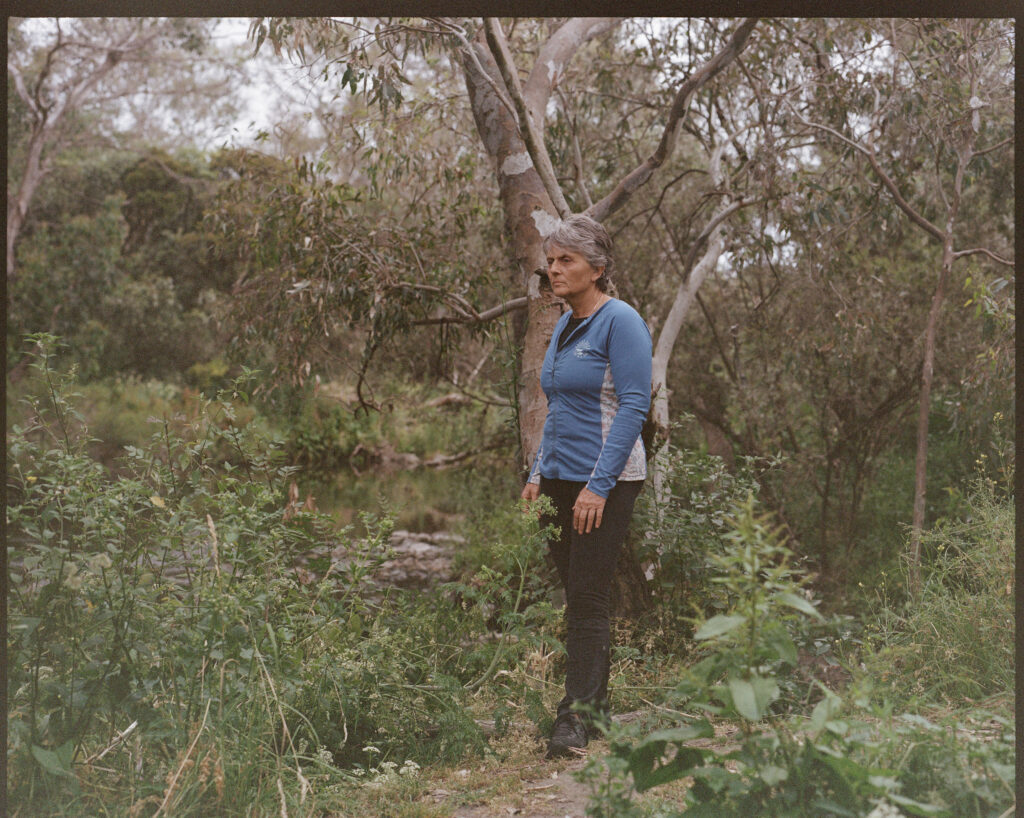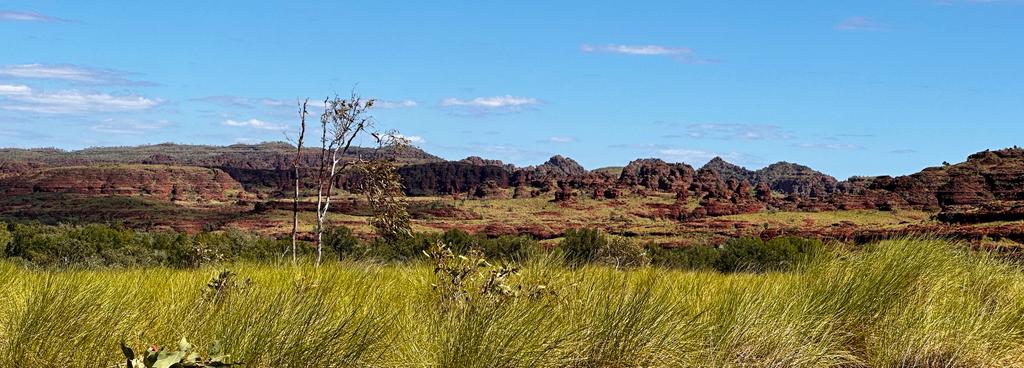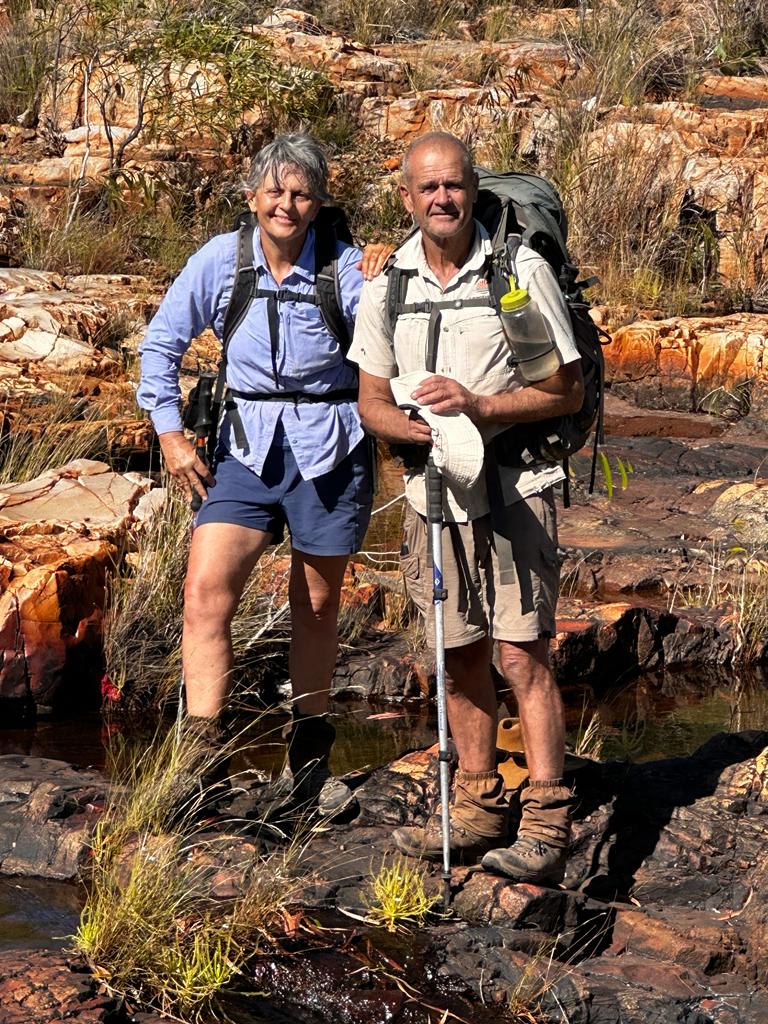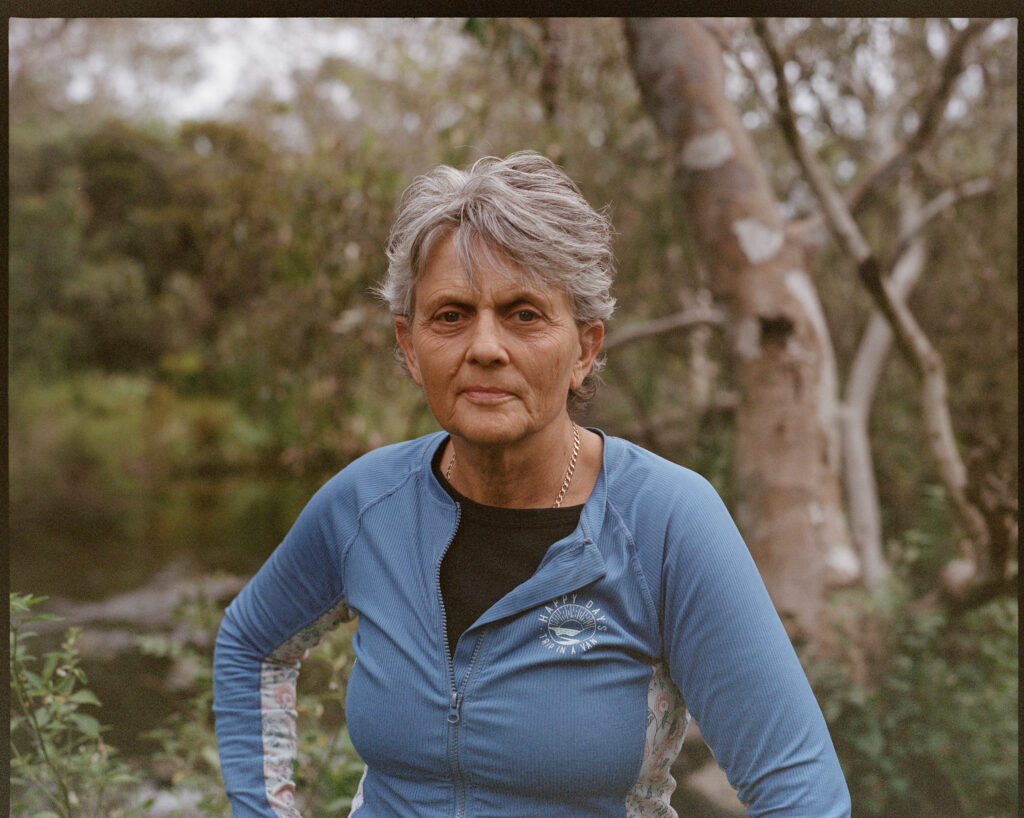Petrine McCrohan is a wild soul.
For her, a wild soul allows the mystery of their inner world to truly meet their external world, our environment. Through her work, Petrine facilitates individuals to meet their environment, supporting this interaction through nature-based activities with intention. Petrine runs Wild Soul Experiences across Australia, together with her facilitation partner Terry Hewett. The focus for both Petrine and Terry is to reconnect people with their inner wisdom through a powerful shared and supported experience in the Australian landscape, which is steeped in natural history and Ancient Aboriginal wisdom. This connection with landscape has been with Petrine throughout her life.
“I felt this connection as a child on my grandfather’s farm, but I wasn’t cognisant of it. But I think that’s where my unconscious goes back to, and as I’ve become more cognisant of it, it has become so important, because that’s what helped me since my childhood. Nature and animals.”
So when did she become cognisant of her connection with landscapes?
“I think when I was working with Aboriginal people on Country, because for them the dream state and having things come to you in dream, and for that to be reflected in landscape and songs and ritual, to them that’s life, there’s nothing unusual about that. I’ll give you an example. I was driving on the Great Northern Highway, past a sign that said Mimbi Caves, and I was fascinated by that, I thought what is that? And I kept driving past that sign and within a few months I had a dream that I was in a cave system, and I was with a very tall Aboriginal woman, and she was in a uniform of some sort, and I went and told this dream to the community I was working with.”
At the time, Petrine was lecturing and working in cultural tourism.
“The custodians of that particular part of the country, they went okay, we know who that is, we know the caves, that’s Mimbi Caves, and they told me the name of the woman I saw and explained she used to work there as a guide. It was all very matter of fact to them but I thought, woah, that’s wild.”

Wild experiences like this weren’t always a part of Petrine’s life. In 2000, she was living in Melbourne, experiencing the monotony that often defines people’s day to day life in a city.
“Over 20 years ago, I was out to dinner with a friend and I asked him, ‘is this it?’ I was standing in a shop, day after day, earning money to live, which meant more days standing in the same shop earning more money. I guess I wanted more from my life. But it actually goes back a bit further. Have you ever heard of the Mungo Man?”
The Mungo Man is the name given to the remains of an Aboriginal man found near Mungo in New South Wales. Petrine was friends with the daughter of Jim Bowler, an Australian geomorphologist — an ancient lakes expert — who discovered human remains at Lake Mungo in 1969, while doing fieldwork for his PhD at the Australian National University.
“During his research Jim came across the bones of what turned out to be an indigenous woman they called Lady Mungo, and then five years later, while still exploring the area, Jim came across an entire skeleton. They later worked out that the man that once used this skeleton had been covered in ochre, and the way he was buried signified some kind of ritual, the oldest record of such a practice. When they dated the bones, it pushed back the amount of time that science believed Aboriginals had been living on this land.
“Anyway, Jim and his daughter took me to Mungo, and we were walking through the sand dunes with an Aboriginal woman, and when we were walking near the spot Jim discovered that skeleton, the woman fell to the ground and started wailing. And I froze, I didn’t know what to do, I hadn’t experienced anything in my life that could inform a response. So I just sat down beside her, not touching her, just sitting there, being there. After a while she told me her story: she was one of the traditional owners of that land, a Mutthi Mutthi elder, a direct descendant of the Mungo Man, and the excavation of his body brought a lot of pain to her community.
“I felt so ignorant in that moment. It felt like I had been living in this cultural bubble, and that feeling stayed with me. I guess it broke the bubble in a way, it changed me, and slowly Melbourne stopped satisfying me, and finally one day I was eating dinner with my friend and I asked, ‘is this it?’ And the reality was that it was, that was what my life amounted to in that moment, but I didn’t want it to, so I needed to change it, and I felt that I could, I could learn, and not just through books, but through experiencing an entirely different way of life.”
Petrine decided to leave Melbourne. Following a non-rational, intuitive process, she ended up in the Kimberley region of Western Australia. She initially found work, two hours each week, as a Personal Growth facilitator in the Bachelor of Counselling degree at the local university, eventually coordinating the entire program. After a year, she left this role and started training as a tour guide. It was through this period that the seed of Wild Soul Experiences began to root.

“I first had the idea of bridging the internal and external landscapes in Melbourne, back in the late 90s, through my understanding of astrology and mythology and symbolism and Jung and all of what I’d studied. It was then that I first thought how nature is reflecting our internal reality, which is why I wanted to become a tour guide, so I could explore the landscape. And when I was training to be a tour guide, I went down through a cave system, and the non-indigenous guide was talking about this ancient painting and I had a full on bodily reaction, I couldn’t stand there, I had to move away, I knew something was going on. That’s how I got into being a cultural tourism lecturer, because one thing led to another and I was in someone’s office and asking why non-indigenous people are interpreting and going to these sites, why aren’t Aboriginal people doing that, and there was an Aboriginal man in the room who asked if I would be interested in being a cultural tourism lecturer. I said ‘sure’.
“Eventually I found the traditional owner, a Bunuba Elder named Dillon, and we eventually worked together, and he eventually interpreted that site with his young people. We developed a tour there. He said to me the ancestors told me to do that, they gave me that bodily sensation, and then everything that happened as a result of that was the ancestors telling me that I had to connect with Dillon, so that I could then help him and his family build a tour that took people through that cave. And it’s actually helped to stop non-indigenous people, or anybody for that matter, apart from the people who were supposed to be doing it, from interpreting any of the sacred sites. But that was another key experience of connecting with the powers of mystery. I met mystery and the mystery of what can happen if you follow these feelings.”
Through her work as a lecturer, and then after, when she left this position and worked more directly with communities as a consultant and facilitator, Petrine deepened her relationship with Aboriginal people and their wisdom of relating to landscape.
“There is such a depth of culture, which is focused on the interconnectedness between the nature of dreams, of stories, of the dreamtime, of the shape of a river. They’d take me to a place where there were these egg-shaped rocks on top of each other, and to anyone else, like to a tourist passing by, they’d think this was just a bunch of rocks. The Elders would take me there — and this is just an example — they’d say these are the eggs of the serpent that comes down this river, and you just go of course they are, they are eggs, it was like a nest, and that kind of thing happened frequently. And then they’d take me to the meeting places for different tribes, and it would be at that place they wouldn’t war and where they’d all come together and they’d do things, they’d exchange ideas, maybe they’d talk about intermarriage, they’d trade, they’d do all of that. And you could feel it in the landscape, you could feel these energies because people were doing the same things in the same spot for thousands and thousands and thousands of years, and there’s an energy that gets embedded there, and that’s what they were constantly trying to teach us, these places are sacred because something was done here over and over again.”

After working as a lecturer, Petrine started freelancing as a consultant and facilitator, often with Stepwise, who developed the Stepping Stones facilitation method to support Aboriginal communities to create their own businesses in their way. This work connected Petrine with the Kimberley Aboriginal Law and Culture Centre (KALACC), who she has been working closely with for over 10 years. KALACC exists “to assist and promote the ceremonies, songs and dance of Kimberley Aboriginal people, to encourage and strengthen their social, cultural and legal values and ensure their traditions a place in Australian society.” All of the projects Petrine worked on with KALACC and Stepwise were centred in the cultural framework and worldview of the communities she worked with, from the Indian Ocean on the Kimberley coast, across to the Tanami Desert in central Australia. Petrine was based in Broome until the end of 2019, when she felt to share more time with her Mother in Corryong, Victoria. Again led by her intuition, Petrine was guided to enjoy her Mother’s presence through the unforeseen last months of her life.
This time of grief coincided with the pandemic, which gave Petrine time to reflect on the many experiences of her life, and the beliefs that fuelled her journey. She was drawn back to the feeling to bridge the internal and external landscapes, focusing on the relationship individuals share with their environment. She began reading books by Bill Plotkin, a depth psychologist focused on the relationship between the human psyche and its natural environment.
“His ideas have informed a lot of what I do, as well as working with Elders on Country. Because a lot of the ideas around the nature-based map of the psyche are not new, indigenous people and spiritual traditions have been doing it for a very long time. Indigenous ways of thinking is that there is a spirit in everything, there’s spirit in the landscape, the landscape holds spirits, it holds knowledge, it holds us, it holds everything. And Bill Plotkin’s ideas were in resonance with the human psyche being involved with nature, that nature is part of our nature, and one reflects the other. And so he goes into an enormous amount of detail in a lot of his books.”
Petrine was inspired. Lockdown was over and, just like she felt 20 years earlier, she was drawn to connect with the Kimberley landscape. This is how she connected with the co-facilitator of the Wild Soul Experiences, Terry Hewett.

“Terry runs Adventure Out in the East Kimberley. I’d met him a couple of times. Originally I went to talk to him about working on an indigenous business in the local community, Doon Doon, just south of Kununurra. And he knew I had worked with this community, he knew I had a connection, I’d done the Stepping Stones with him years before. And so that was it, that was the beginning, I went to Terry and said, ‘I’m here, I’d love to go out on a walk’, and he said ‘yes by all means come out’. And as we walked, we talked, we shared, and it was almost like by being out there in that wilderness area, it started to evoke this impulse to do something with him, because I started to describe what I’d been through and he too saw the wilderness as a temple, as something really special and sacred. Anyway, it really came out of that meeting and from then I started to do some research into the nature-based map of psyche, I started reading and writing and mapping out my own booklet, and it just went from there.”
In 2022, Petrine and Terry guided their first Wild Soul Experience.
“I hold space for people to invite themselves into their own process, and I create a symbolic representation of that: I gather some items from the natural world or draw a little circle or create a little altar. And we sit on the Earth and set an intention, what’s the intention of today, why are we all here? And people speak to that if they feel too, and then we invite them to walk. People go off and do their thing. The whole idea is to move out of your head and to allow your senses to operate as strongly as they can in the environment. And then we return to the group and we usually sit in a circle and we share, ‘this is what happened to me’.
“I have certain activities that I run to give a bit of structure in between the walks, I have little rituals that I do at different moments. Like every morning I do dreams, who’s had a dream, let’s have a look at any dreams that have come through. There’s also journalling, there’s artwork, there’s active imagination activities. And during their walk, participants can sit, they can write, they can journal, whatever feels right in the moment. And after, when we reflect on the experience as a group, when people are speaking, there’s no need to say anything to them, we don’t interpret. That’s one thing I find really interesting in the world that we live in, how everyone feels compelled to jump in and fix things or say ‘oh I’m sad to hear that’. And in my view the whole power of the interaction is being present for it, to be in the circle with that person and what they are saying. In the Wild Soul Experiences, it’s important to allow Country to speak, and to reflect on that interaction with the participants.
“Basically the whole intention of Wild Soul Experiences is to uncover access points to the unconscious mind, so that people can take away tools to interact with the external and the internal world in their daily lives. Because if we’re not doing this, if we’re not interacting with the external and the internal at any given moment, we’re dissociating.

“I’ve got this thing with feathers, feathers often arrive in my path, and it’s just something I notice, the feathers are there for me, it’s always the same colour, and it’s not all the time, it’s in particular moments. So when I see the feather I think what was happening in my body and what was I thinking about at the time that I saw that feather? It’s synchronistic, it’s the internal psyche and the external world coming together, there’s less of a gap with the unconscious. Because when we develop a relationship with the unconscious, we develop a sense of wholeness, and disperse with the idea of perfection and growth. I’m so over growth, I’m done growth. I’m into depth.
“I see the unconscious as something we need to drill down into. We’ve got to get to the bottom of things. This whole growth thing, I’m going to do this so that I can do some more personal growth, it’s like going to exercise classes. If that’s all you can do, exercise classes are great, they’re wonderful, they’ve been really helpful for me, but I do a lot of nature work as well. I’m trying to get people away from this kind of personal growth culture of keeping fit. There’s a depth there, an unconscious mind. You cannot have a full life without a relationship with your unconscious mind, and that’s the way I see the natural world, it is a reflection of our unconscious. If I choose to listen to it, to nature, it always provides me with information about what’s going on unconsciously.”
It’s a courageous and powerful way to live, not seeing a separation with nature and listening to our environment and all it has to teach us. It has certainly guided Petrine to experience the beauty, meaning and mystery embedded in life.
Anton Rivette is a writer and photographer. He leads storytelling at eco-nnect.













